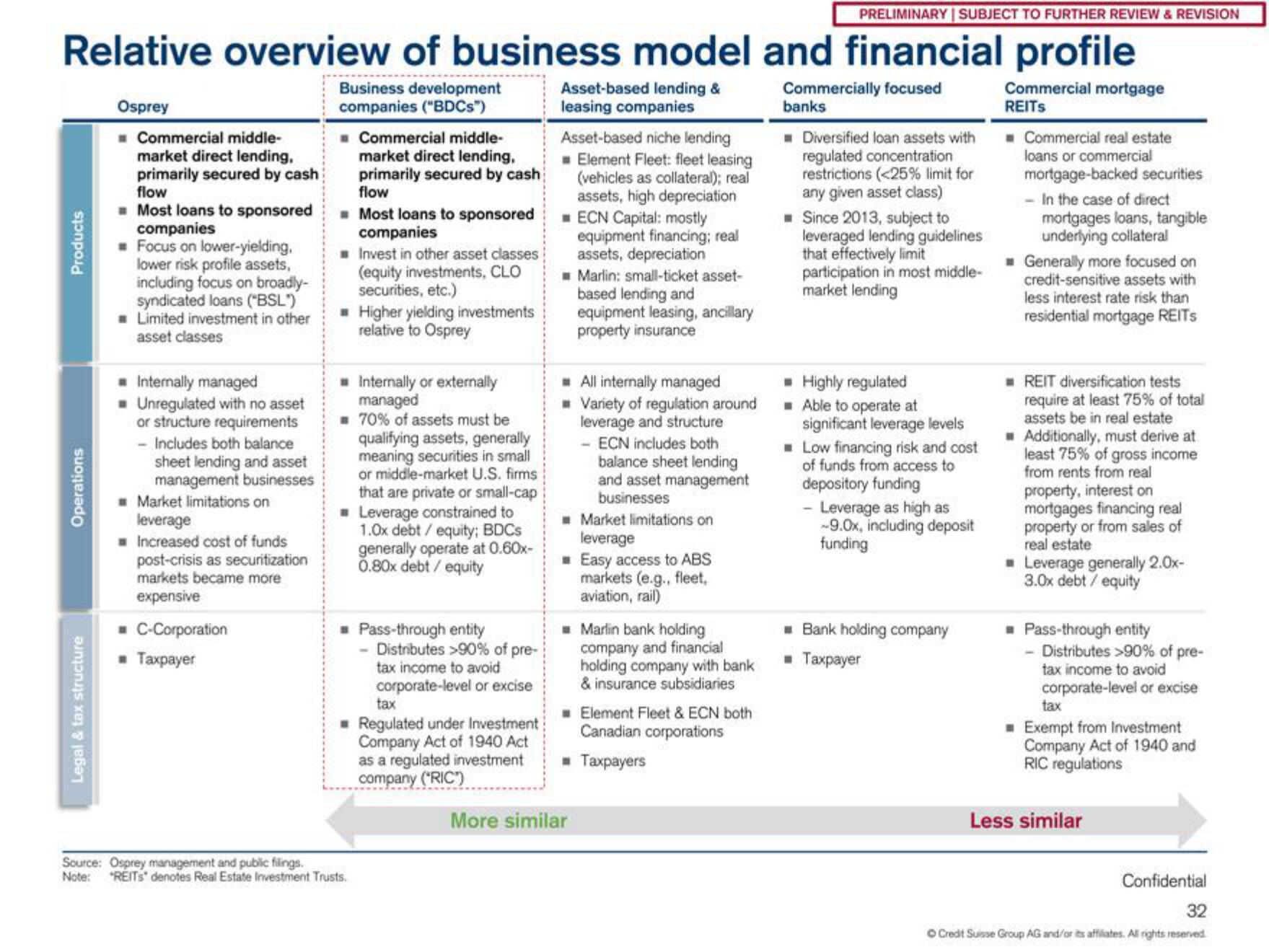Credit Suisse Investment Banking Pitch Book
PRELIMINARY | SUBJECT TO FURTHER REVIEW & REVISION
Relative overview of business model and financial profile
Osprey
Asset-based lending &
leasing companies
Commercially focused
banks
Products
Operations
Legal & tax structure
Commercial middle-
market direct lending,
primarily secured by cash
flow
■ Most loans to sponsored
companies
■ Focus on lower-yielding,
lower risk profile assets,
including focus on broadly-
syndicated loans (BSL)
■ Limited investment in other
asset classes
Internally managed
■ Unregulated with no asset
or structure requirements
- Includes both balance
sheet lending and asset
management businesses
■ Market limitations on
leverage
Increased cost of funds
post-crisis as securitization
markets became more
expensive
C-Corporation
■ Taxpayer
Business development
companies ("BDCs")
Commercial middle-
market direct lending,
primarily secured by cash
flow
Most loans to sponsored
companies
Invest in other asset classes
(equity investments, CLO
securities, etc.)
Source: Osprey management and public filings.
Note: "REITS denotes Real Estate Investment Trusts.
Higher yielding investments
relative to Osprey
Internally or externally
managed
■ 70% of assets must be
qualifying assets, generally
meaning securities in small
or middle-market U.S. firms
that are private or small-cap
Leverage constrained to
1.0x debt / equity; BDCs
generally operate at 0.60x-
0.80x debt / equity
Pass-thro entity
- Distributes >90% of pre-
tax income to avoid
corporate-level or excise
tax
Regulated under Investment
Company Act of 1940 Act
as a regulated investment
company ("RIC")
Asset-based niche lending
Element Fleet: fleet leasing
(vehicles as collateral); real
assets, high depreciation
■ ECN Capital: mostly
equipment financing; real
assets, depreciation
Marlin: small-ticket asset-
based lending and
equipment leasing, ancillary
property insurance
All internally managed
Variety of regulation around
leverage and structure
- ECN includes both
balance sheet lending
and asset management
businesses
Market limitations on
leverage
Easy access to ABS
markets (e.g., fleet,
aviation, rail)
☐ Marlin bank lding
company and financial
holding company with bank
& insurance subsidiaries
■ Element Fleet & ECN both
Canadian corporations
■ Taxpayers
More similar
■ Diversified loan assets with
regulated concentration
restrictions (<25% limit for
any given asset class)
■ Since 2013, subject to
leveraged lending guidelines
that effectively limit
participation in most middle-
market lending
Highly regulated
■ Able to operate at
significant leverage levels
☐ Low financing risk and cost
of funds from access to
depository funding
- Leverage as high as
-9.0x, including deposit
funding
Bank holding company
■ Taxpayer
Commercial mortgage
REITS
Commercial real estate
loans or commercial
mortgage-backed securities
- In the case of direct
mortgages loans, tangible
underlying collateral
Generally more focused on
credit-sensitive assets with
less interest rate risk than
residential mortgage REITS
■ REIT diversification tests
require at least 75% of total
assets be in real estate
Additionally, must derive at
least 75% of gross income
from rents from real
property, interest on
mortgages financing real
property or from sales of
real estate
☐ Leverage generally 2.0x-
3.0x debt / equity
Pass-through entity
- Distributes >90% of pre-
tax income to avoid
corporate-level or excise
tax
■ Exempt from Investment
Company Act of 1940 and
RIC regulations
Less similar
Confidential
32
Ⓒ Credit Suisse Group AG and/or its affiliates. All rights reserved.View entire presentation